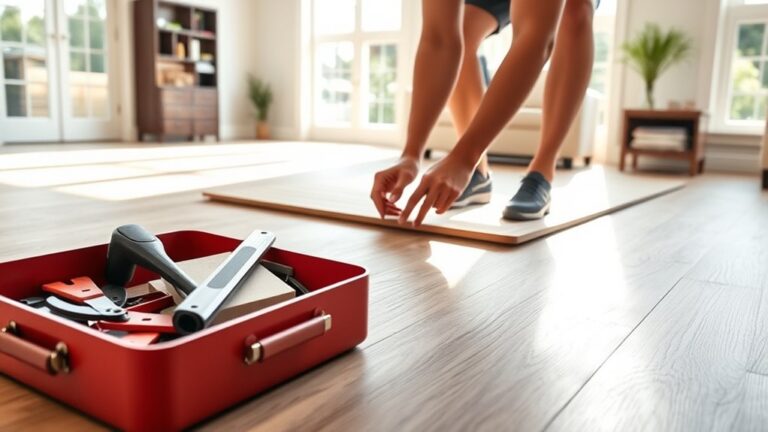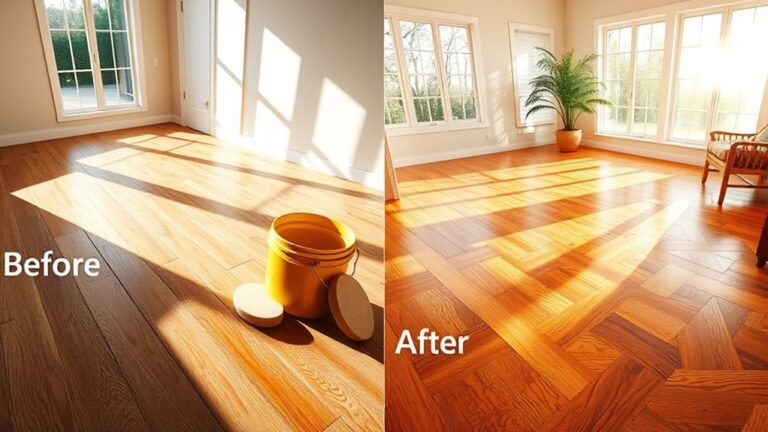To do stairs with vinyl flooring, measure and cut the vinyl planks to fit the steps, starting from the top and moving down. Then, apply adhesive to the stairs and press the vinyl planks firmly into place, ensuring they are well-adhered and free of air bubbles.
Introducing vinyl flooring on stairs can be a practical and stylish solution for enhancing the overall look and durability of your staircase. Vinyl flooring offers various benefits, including easy maintenance, water resistance, and affordability. Whether you are renovating your home or simply looking to update your staircase, learning how to install vinyl flooring on stairs can be a useful skill.
In this guide, we will provide a step-by-step process for achieving a professional-looking result. By following these instructions, you can transform your staircase with vinyl flooring and enjoy its numerous advantages for years to come.
Choosing The Right Vinyl Flooring For Stairs
Vinyl flooring has become a popular choice for stairs due to its durability and slip resistance. When considering the right vinyl flooring for your stairs, it is important to evaluate different options. Look for vinyl flooring that is specifically designed for high-traffic areas such as stairs, as it will be more durable and resistant to wear. Additionally, check for a textured surface or embossed design, as this will provide better traction and reduce the risk of slipping.
Another factor to consider is the thickness of the vinyl flooring. Thicker vinyl flooring typically offers better durability and sound insulation, making it a great option for stairs. Additionally, consider the overall style and design of the vinyl flooring to ensure it complements your existing decor.
Once you have evaluated different options, carefully select the most suitable vinyl flooring for your stairs. Ensure it meets your requirements for durability, slip resistance, and style. With the right choice, you can enjoy beautiful and functional stairs with vinyl flooring.
Preparing The Stairs For Vinyl Flooring Installation
Inspecting the condition of the stairs is an essential step in preparing for vinyl flooring installation. Check for any signs of damage, such as cracks or loose boards, as these issues should be addressed before proceeding. Clean and smooth out any imperfections on the surface to ensure a flat and even base for the vinyl flooring. This can be done by sanding down rough spots or filling in any gaps or holes. If there is existing carpet or flooring on the stairs, it needs to be removed before proceeding with the installation. Ensure that the surface is clean and free of any debris or adhesive residue.
Step 1: Measuring And Planning
Accurately measure the dimensions of each stair. Determine the amount of vinyl flooring required. Plan the installation process. When measuring the dimensions of each stair, be sure to measure the length, width, and depth of each step. This will ensure that you have the correct dimensions when purchasing vinyl flooring. To determine the amount of vinyl flooring required, calculate the area of each step by multiplying the length and width. Add up the total area of all the steps to determine the amount of vinyl flooring needed. When planning the installation process, consider the direction in which you want the vinyl flooring to run. Start at the top of the stairs and work your way down, cutting each piece of vinyl to fit each step. Use a flooring adhesive to secure the vinyl to the stairs, making sure to smooth out any bubbles or wrinkles. Finally, trim any excess vinyl and enjoy your new vinyl stairs.
Step 2: Removing Existing Nose Edging
To start the process of installing vinyl flooring on stairs, you need to remove the existing nose edging. This is an important step to ensure a smooth and seamless transition between the vinyl flooring and the stairs. Here is how you can identify and remove the existing nose edging:
| Step 1: | Begin by examining the stairs to locate the existing nose edging, which is usually a strip of metal or wood. |
| Step 2: | Using a screwdriver or pry bar, gently pry off the nose edging starting from one end. Be careful not to damage the stairs or the edging. |
| Step 3: | If the nose edging is secured with screws, carefully unscrew them and set them aside for future use. |
| Step 4: | Once the nose edging is removed, inspect the stairs for any nails or staples that were used to secure it. Remove any remaining hardware to ensure a clean surface. |
With the existing nose edging removed, the stairs are now ready for the installation of new edging, which will be covered in the next step.
Step 3: Cutting Vinyl Flooring For Stair Treads
In Step 3 of how to do stairs with vinyl flooring, you will need to cut the vinyl flooring for each stair tread. First, measure and mark the vinyl flooring to ensure it is the correct size for each step. Use a tape measure to measure the width and length of each tread, and mark these measurements on the back of the vinyl flooring using a pencil or marker.
Next, use a sharp utility knife to cut the vinyl flooring along the marked lines. Take your time and use steady pressure to ensure a clean and accurate cut. It may be helpful to make several shallow scores along the line before cutting all the way through to prevent any tearing or jagged edges.
Once the vinyl flooring is cut to the correct size and shape, you can move on to the next step in the installation process. Repeat this process for each stair tread to ensure a professional and seamless finish.
Step 4: Applying Vinyl Flooring Adhesive
When applying vinyl flooring to stairs, it is crucial to use a vinyl flooring-specific adhesive to ensure proper adhesion. The adhesive should be applied to the stair treads, ensuring complete coverage. This will help to prevent the vinyl flooring from lifting or coming loose over time, providing a durable and long-lasting finish. Using a vinyl flooring-specific adhesive is important as it is specifically designed to work with vinyl materials, providing the necessary bond for a reliable installation. Make sure to follow the manufacturer’s instructions for the specific adhesive being used, including any recommended drying time before moving onto the next step. By taking the time to properly apply the vinyl flooring adhesive, you can achieve a professional-looking finish on your stairs.
Step 5: Installing Vinyl Flooring On Stair Treads
Installing vinyl flooring on stair treads requires careful positioning of the vinyl planks. Start by laying the planks from the bottom step to the top, making sure they line up with the nosing of each step. Smooth out any air bubbles or wrinkles that may have formed during installation to ensure a seamless appearance.
To secure the vinyl flooring firmly in place, use a combination of adhesive and nails. Apply the adhesive to the back of each plank, making sure to cover the entire surface. Then, press the plank onto the step, using a hand roller to eliminate any air pockets.
Additionally, insert nails along the edges of each plank to provide extra stability. Place the nails about 1 inch from the edge and space them approximately 6 inches apart. This will help to anchor the vinyl flooring securely to the stair treads.
Step 6: Fitting Vinyl Flooring Around Stair Nosing
To fit vinyl flooring around stair nosing, you need to measure and cut the vinyl flooring according to the dimensions of the stair nosing. Start by measuring the width and length of the stair nosing, taking into consideration any overlap required for a secure fit. Use a utility knife or a vinyl cutter to cut the vinyl flooring to the measured dimensions.
Next, attach the vinyl flooring to the stair nosing securely. Apply an adhesive specifically designed for vinyl flooring on the back of the cut vinyl piece. Press the vinyl firmly onto the stair nosing, ensuring all edges are properly aligned. Use a roller or a hand tool to smooth out any air bubbles or wrinkles in the vinyl. Allow the adhesive to dry according to the manufacturer’s instructions before moving forward with the installation process.
Step 7: Applying Finishing Touches
Clean the installed vinyl flooring thoroughly: Before applying any finishing touches, it is important to clean the installed vinyl flooring thoroughly. This will ensure that there is no dirt or dust trapped underneath the flooring, which can affect the overall appearance and longevity of the flooring.
Trim excess vinyl flooring neatly along the edges: Once the flooring is clean, you can begin trimming the excess vinyl neatly along the edges. This step is crucial to achieve a professional and polished look. Use a sharp utility knife or a vinyl cutter to carefully trim the excess vinyl, making sure to follow the contours and edges of the stairs.
Regular Cleaning And Maintenance
Vacuum or sweep the stairs regularly: Keeping your vinyl flooring stairs clean is essential to maintain their appearance and durability. Regularly vacuuming or sweeping the stairs will help remove dirt, dust, and debris that can scratch the surface.
Use appropriate cleaning solutions for vinyl flooring: When it comes to cleaning vinyl flooring, it’s important to use cleaning solutions that are specifically designed for this type of flooring. Check the manufacturer’s recommendations to ensure you’re using the right products to avoid damaging the vinyl.
Address stains and spills promptly: Accidents happen, and if you find a stain or spill on your vinyl flooring stairs, it’s important to address it promptly. Wipe up spills immediately using a damp cloth or mop, and use a mild cleaner if necessary to remove any stains. Promptly addressing stains and spills will help prevent them from becoming more difficult to clean.
Protecting Vinyl Flooring On Stairs
When it comes to protecting vinyl flooring on stairs, there are a few key strategies to keep in mind. Firstly, consider placing mats or rugs on high traffic areas. This will help to minimize wear and tear and provide a protective barrier for your vinyl flooring. Additionally, it is important to avoid dragging heavy objects across the flooring. This can cause scratches and damage the surface. Instead, lift and carry objects whenever possible. Lastly, using furniture pads is a smart way to prevent scratches and dents caused by furniture movement. Apply these pads to the bottom of chair legs, table legs, and any other furniture that may come in contact with the vinyl flooring. By following these practices, you can ensure the longevity and beauty of your vinyl flooring on stairs.
Repairing Vinyl Flooring On Stairs
When it comes to repairing vinyl flooring on stairs, it is important to know how to fix minor damages like scratches and tears. These small damages can be easily addressed to maintain the overall appearance of the vinyl flooring. One way to address these issues is by using a vinyl floor repair kit, which usually includes a putty knife, a heat gun or iron, and a vinyl patch.
To fix scratches, gently sand the damaged area until smooth and clean. Then, apply a small amount of vinyl repair adhesive and smooth it out using the putty knife. Allow it to dry, and then sand it again to make it even with the rest of the flooring.
If there are tears in the vinyl flooring, start by cutting away any loose or frayed edges. Apply adhesive to the torn area and press it firmly together. Use a heavy object or a clamp to hold it in place while it dries. Once dried, use a heat gun or iron to seal the edges and make it seamless.
In addition to fixing minor damages, it may be necessary to replace heavily damaged or worn sections of vinyl flooring. This can be done by carefully removing the damaged section with a utility knife or a flooring removal tool. Measure the area that needs to be replaced and cut a new vinyl flooring piece to fit. Apply adhesive to the subfloor and press the new piece into place. Make sure to follow the manufacturer’s instructions for drying times and any additional adhesive or sealant requirements.

Frequently Asked Questions On How To Do Stairs With Vinyl Flooring
Can Vinyl Flooring Be Used On Stairs?
Yes, vinyl flooring can be used on stairs. It provides a durable and slip-resistant surface, making it a popular choice. Vinyl stairs can be installed easily and come in various styles and designs to match any décor.
How Do You Transition Vinyl Plank Flooring To Stairs?
To transition vinyl plank flooring to stairs, follow these steps: 1. Measure and cut vinyl planks to fit the stairs. 2. Attach the planks to the stairs using adhesive or nails. 3. Trim the edges for a neat finish. 4.
Install stair nosing to protect the edges and add safety. 5. Repeat the process for each stair until completed.
Do You Need To Glue Down Vinyl Plank Flooring On Stairs?
No, it is not necessary to glue down vinyl plank flooring on stairs.
How Do You Fit Vinyl Flooring To Stairs?
To fit vinyl flooring to stairs, follow these steps: 1. Measure and cut vinyl planks or sheets to fit each stair tread and riser. 2. Clean and prepare the stairs by removing any existing flooring or adhesive. 3. Apply a strong adhesive to the stairs and carefully press the vinyl in place, ensuring a tight fit.
4. Use a hand roller to smooth out any bubbles or wrinkles. 5. Finish by installing stair nosing or trim for a polished look.
Conclusion
Vinyl flooring is a durable and versatile option for stairs, offering a range of benefits such as easy installation, low maintenance, and resistant to moisture and stains. By following the step-by-step process outlined in this guide, you can confidently tackle the task of installing vinyl flooring on your stairs.
Remember to measure accurately, prepare the surface properly, and select the right materials and tools. With proper care, your vinyl flooring stairs will not only enhance the aesthetic appeal of your home but also provide a safe and comfortable walking surface for years to come.




